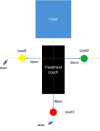Augmented reality-guided positioning system for radiotherapy patients
- PMID: 34985188
- PMCID: PMC8906221
- DOI: 10.1002/acm2.13516
Augmented reality-guided positioning system for radiotherapy patients
Abstract
In modern radiotherapy, error reduction in the patients' daily setup error is important for achieving accuracy. In our study, we proposed a new approach for the development of an assist system for the radiotherapy position setup by using augmented reality (AR). We aimed to improve the accuracy of the position setup of patients undergoing radiotherapy and to evaluate the error of the position setup of patients who were diagnosed with head and neck cancer, and that of patients diagnosed with chest and abdomen cancer. We acquired the patient's simulation CT data for the three-dimensional (3D) reconstruction of the external surface and organs. The AR tracking software detected the calibration module and loaded the 3D virtual model. The calibration module was aligned with the Linac isocenter by using room lasers. And then aligned the virtual cube with the calibration module to complete the calibration of the 3D virtual model and Linac isocenter. Then, the patient position setup was carried out, and point cloud registration was performed between the patient and the 3D virtual model, such the patient's posture was consistent with the 3D virtual model. Twenty patients diagnosed with head and neck cancer and 20 patients diagnosed with chest and abdomen cancer in the supine position setup were analyzed for the residual errors of the conventional laser and AR-guided position setup. Results show that for patients diagnosed with head and neck cancer, the difference between the two positioning methods was not statistically significant (P > 0.05). For patients diagnosed with chest and abdomen cancer, the residual errors of the two positioning methods in the superior and inferior direction and anterior and posterior direction were statistically significant (t = -5.80, -4.98, P < 0.05). The residual errors in the three rotation directions were statistically significant (t = -2.29 to -3.22, P < 0.05). The experimental results showed that the AR technology can effectively assist in the position setup of patients undergoing radiotherapy, significantly reduce the position setup errors in patients diagnosed with chest and abdomen cancer, and improve the accuracy of radiotherapy.
Keywords: augmented reality; position setup; position setup error; radiation therapy.
© 2022 The Authors. Journal of Applied Clinical Medical Physics published by Wiley Periodicals, LLC on behalf of The American Association of Physicists in Medicine.
Conflict of interest statement
The authors declare that there is no conflict of interest that could be perceived as prejudicing the impartiality of the research reported.
Figures





Similar articles
-
Innovative integration of augmented reality and optical surface imaging: A coarse-to-precise system for radiotherapy positioning.Med Phys. 2023 Jul;50(7):4505-4520. doi: 10.1002/mp.16417. Epub 2023 Apr 15. Med Phys. 2023. PMID: 37060328
-
Evaluation of setup and intrafraction motion for surface guided whole-breast cancer radiotherapy.J Appl Clin Med Phys. 2019 Jun;20(6):39-44. doi: 10.1002/acm2.12599. J Appl Clin Med Phys. 2019. PMID: 31187538 Free PMC article.
-
A Noninvasive Method to Reduce Radiotherapy Positioning Error Caused by Respiration for Patients With Abdominal or Pelvic Cancers.Technol Cancer Res Treat. 2019 Jan 1;18:1533033819825865. doi: 10.1177/1533033819825865. Technol Cancer Res Treat. 2019. PMID: 30803363 Free PMC article.
-
A review of setup error in supine breast radiotherapy using cone-beam computed tomography.Med Dosim. 2016 Autumn;41(3):225-9. doi: 10.1016/j.meddos.2016.05.001. Epub 2016 Jun 14. Med Dosim. 2016. PMID: 27311516 Review.
-
Surface-Guided Radiotherapy: Can We Move on from the Era of Three-Point Markers to the New Era of Thousands of Points?Bioengineering (Basel). 2023 Oct 16;10(10):1202. doi: 10.3390/bioengineering10101202. Bioengineering (Basel). 2023. PMID: 37892932 Free PMC article. Review.
Cited by
-
Head model dataset for mixed reality navigation in neurosurgical interventions for intracranial lesions.Sci Data. 2024 May 25;11(1):538. doi: 10.1038/s41597-024-03385-y. Sci Data. 2024. PMID: 38796526 Free PMC article.
-
The Feasibility and Accuracy of Holographic Navigation with Laser Crosshair Simulator Registration on a Mixed-Reality Display.Sensors (Basel). 2024 Jan 30;24(3):896. doi: 10.3390/s24030896. Sensors (Basel). 2024. PMID: 38339612 Free PMC article.
-
Machine learning-based radiotherapy time prediction and treatment scheduling management.J Appl Clin Med Phys. 2023 Sep;24(9):e14076. doi: 10.1002/acm2.14076. Epub 2023 Aug 17. J Appl Clin Med Phys. 2023. PMID: 37592451 Free PMC article.
-
A Novel Registration Method for a Mixed Reality Navigation System Based on a Laser Crosshair Simulator: A Technical Note.Bioengineering (Basel). 2023 Nov 7;10(11):1290. doi: 10.3390/bioengineering10111290. Bioengineering (Basel). 2023. PMID: 38002414 Free PMC article.
-
Feasibility evaluation of radiotherapy positioning system guided by augmented reality and point cloud registration.J Appl Clin Med Phys. 2024 Apr;25(4):e14243. doi: 10.1002/acm2.14243. Epub 2024 Jan 16. J Appl Clin Med Phys. 2024. PMID: 38229472 Free PMC article.
References
-
- Olaciregui‐Ruiz I, Rozendaal R, Mijnheer B, Mans A. Site‐specific alert criteria to detect patient‐related errors with 3D EPID transit dosimetry. Med Phys. 2019;46:45‐55. - PubMed
-
- Chin S, Eccles CL, McWilliam A, et al. Magnetic resonance‐guided radiation therapy: a review. J Med Imaging Radiat Oncol. 2020;64:163‐177. - PubMed
MeSH terms
Grants and funding
- M2020006/General Program of Jiangsu Provincial Health Commission
- CM20193005/Changzhou Key Laboratory of Medical Physics
- CZQM2020067/Young Talent Development Plan of Changzhou Health Commission
- QN201932/Science and Technology Programs for Young Talents of Changzhou Health Commission
- 2021K009/Changzhou NO.2 People's Hospital
LinkOut - more resources
Full Text Sources
Other Literature Sources
Medical
Research Materials

